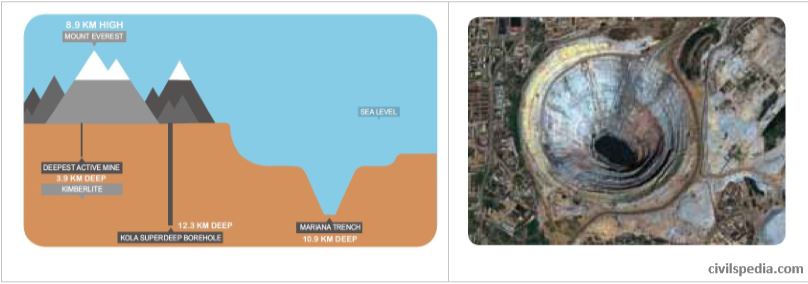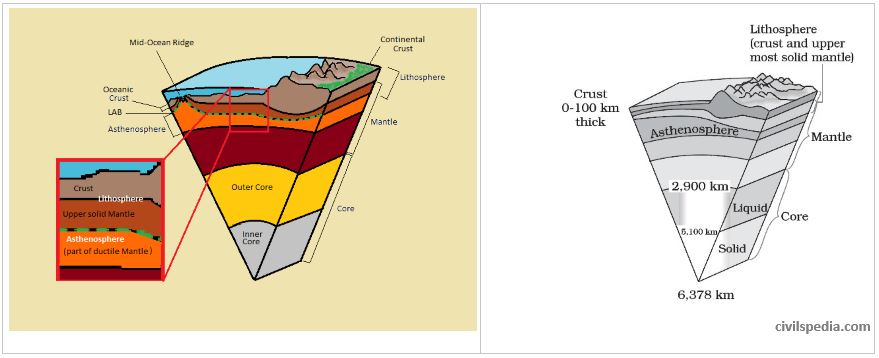Table of Contents
Interior of Earth
This article deals with ‘Interior of Earth and Earths’s Magnetism .’ This is part of our series on ‘Geography’ which is important pillar of GS-1 syllabus . For more articles , you can click here
Direct and Indirect Evidences
The interior of the earth can be understood only by indirect evidences as neither any one has nor any one can reach the interior of the earth. Various studies are done to reach at conclusion about structure of the Earth .

1 . Direct evidences
- By analysing the lava of the volcanoes coming out . However, it is difficult to ascertain the depth of the source of such magma.
- By analysing the deepest mines of earth . However, deepest mine is not more than 12 km deep (Kola Deep Borehole of Russia) .

2 . Indirect evidences
- Finding the rate of increase of Temperature , pressure and density with increasing depth give information about material present
- Gravity anomalies (gravitational value is not same at all places) . It gives information regarding the unequal distribution of mass of material in the earth’s crust.
- Study of Movement of seismic wave (dealt below)
- Meteors that at times reach the earth. Meteors have developed out of materials same as our planet.
- Magnetic surveys provide information about the distribution of magnetic materials in crustal portion.
Earthquake & Seismic Waves
- An earthquake in simple words is shaking of the earth. It is caused due to release of energy , which generates waves that travel in all directions.
- The study of seismic waves provides a complete picture of the layered interior.
Waves generated by Earthquake

a. Body waves
- Generated due to the release of energy at focus (ie point inside earth where earthquake occurs) and move in all directions travelling through the body of the earth. Hence, the name body waves.
- It is of two types namely P-waves and S-waves.
b. Surface Wave
- The body waves interact with the surface rocks and generate new set of waves called surface waves.
- These waves move along the surface.
- The velocity of waves changes as they travel through materials with different densities. The denser the material, the higher is the velocity.
- They are most destructive . They cause displacement of rocks, and hence, the collapse of structures occurs.
- They are of two types ie Rayleigh and Love waves
- But in study of earth’s structure they don’t play much role.

Type of Body Waves
There are two types of body waves ie P and S-waves.
a.a P-Waves
- These are also called ‘primary waves’.
- The P-waves are similar to sound waves. They can travel through gaseous, liquid and solid materials.
a.b S-Waves
- S-waves arrive at the surface with some time lag. These are called secondary waves.
- An important fact about S-waves is that they can travel only through solid materials. This characteristic of the S-waves is quite important. It has helped scientists to understand the structure of the interior of the earth.
Emergence of Shadow zones and inferring Earth’s structure
- Earthquake waves get recorded in seismographs located at far off locations. However, there exist some specific areas where the waves are not reported. Such a zone is called the ‘shadow zone’. The study of different events reveals that for each earthquake, there exists an altogether different shadow zones.
- Observations were.
- Seismographs located at any distance within 105° from the epicentre, recorded the arrival of both P and S-waves.
- Between 105° & 145° , no wave was recorded ie Shadow Zone for both P & S Waves
- Seismographs located beyond 145° from epicentre, record the arrival of P-waves, but not that of S-waves.

- From this scientists have
concluded that,
- Till 2900 Km , there is solid surface ie Mantle
- Outer core is made up of liquid (because S wave cant travel through Liquid) .
- Inside Liquid Core there is again Solid Core (inferred from the deflection of P-Waves inside Core) .
Structure of Earth

1 . Crust
- It is the outermost solid part of the earth.
- It is brittle in nature.
- The thickness of the crust varies under the oceanic and continental areas.
| Continental Crust | Oceanic Crust |
| Average thickness of 30 km(thicker) | Average thickness of 5 km( thinner) |
| Less dense (density = 2.7 gm/cm3) | More dense (density = 3 gm/cm3) |
| Continental Crust is made up of SiAl ie Silica and Aluminium | It is made up of SiMa ie Silica and Magnesium |
Note – The continental crust is thicker in the areas of major mountain systems. It is as much as 70 km thick in the Himalayan region.
Not many iron loving compounds are found in earth’s crust because they were depleted & relocated deeper .
2. Mantle
- The portion of the interior beyond the crust is called the mantle. The mantle extends from Moho’s discontinuity to a depth of 2,900 km.
- The crust and the uppermost part of the mantle (roughly upper 80 km) is called lithosphere . (Entire lithosphere is broken into brittle moving plates (called tectonic plates) containing worlds continents & oceans . Lithosphere appears to be floating on asthenosphere) .
- The upper portion of the mantle is called asthenosphere. The word astheno means weak. It is semi fluid material at high temperature. It is considered to be extending upto 400 km . It is the main source of magma that finds its way to the surface during volcanic eruptions.
- Mantle is composed of silica, magnesium and iron.
- It has a density higher than the crust (3.4 g/cm3).
- The lower mantle extends beyond the asthenosphere. It is in solid state.
3. Core
- As indicated earlier, the earthquake wave velocities helped in understanding the existence of the core of the earth. The core-mantle boundary is located at the depth of 2,900 km
- Outer Core : 2900 to 5100 Km : Liquid
- Inner Core : 5100 to 6400 Km : Solid
- The outer core is in liquid state while the inner core is in solid state.
- Its temperature is about 5500 C to 6000 C
- The density of material at the mantle- core boundary is around 5 g/cm3 and at the centre of the earth at 6,300 km, the density value is around 14g/cm3.
- The core is made up of very heavy material mostly constituted by nickel and iron.
- It is sometimes referred to as the NIFE layer (Barysphere).
Points : crust, mantle ,core are chemical composition based divisions whereas lithosphere, asthenosphere are physical state based division.
(GK) Composition with Earth as whole
- Iron
- Oxygen
- Silicon
Side Topic : Discontinuities interior of Earth
| Conrod Discontinuity | discontinuity between the Continental Crust and Oceanic Crust |
| Moho Discontinuity | discontinuity between the crust and mantle is called as the Mohorovich Discontinuity or Moho discontinuity. |
| Gutenburg Discontinuity | core is separated from the mantle by Guttenberg’s Discontinuity. |
| Lehmann Discontinuity | Discontinuity between Outer Core & Inner Core |

Lithosphere , Asthenosphere , Mesosphere and Barysphere
Above classification was on the basis of chemical composition whereas this classification is on the basis of physical characteristics/rigidity.
1 . Lithosphere
- Lithos means rock => Lithosphere is the layer containing hard rocks
- It’s average thickness is 80 km . Hence, it contains crust and upper solid mantle.
2. Asthenosphere
- Asthenos means ‘a weak zone’ => Asthenosphere is the layer in plastic state.
- It’s thickness is upto 400 km from the surface. Hence, it is made up of Mantle
3. Mesosphere
- It is rigid in structure
- It consist of rest of Mantle below the Asthenosphere.
4. Barysphere
- It consist of Inner and Outer Core

Earth’s Magnetism
- Magnetic field of Earth is similar to that of a bar magnet tilted 11 degrees from the spin axis of the Earth.

Cause
- Earth’s magnetic field is
attributed to a dynamo effect of circulating electric current in the core of the Earth.
- At the Earth’s centre is a solid inner core surrounded by a fluid outer core
- These convection currents, combined with the rotation of the Earth, are thought to generate a “geodynamo” that powers the magnetic field.
Significance if Earth’s Magnetism
- Atmosphere protection: Magnetosphere deflects most of the solar wind, whose charged particles would otherwise strip away the ozone layer that protects the Earth from harmful ultraviolet radiation
- Rock Dating: The magnetic reversals provide the basis for magneto-stratigraphy, a way of dating rocks and sediments.
- Aurora: Interaction of the terrestrial magnetic field with particles from the solar wind near the poles
- Navigation: Humans have used Earth’s magnetic field for navigation purpose since ages. Various organisms ranging from bacteria to pigeons use it for navigation and orientation purposes.
